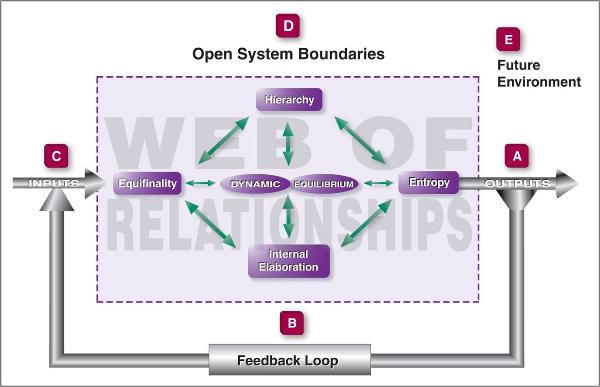The Systems Thinking Approach ®
“Systems Thinking: The natural way the world works”
Overview–“The DNA of Successful Organizations”
The Haines Centre for Strategic Management advocates the Science of Systems Thinking as embodied by General Systems Theory and the Society of General Systems Research (now ISSS). The Systems Thinking Approach® is our foundation, Core Technology and world view in our lives and all our consulting and training work with clients. Why?
Systems Thinking is a heavily researched and rigorous macro-scientific theory with its roots in the Universal Laws of Living Systems on Earth and in ecology and biology. It is analogous to DNA in humans; it defines our life-giving characteristics. An Austrian, Ludwig Von Bertalanffy is the father of what he called General Systems Theory when he formed the Society of General Systems Research in 1954 with Margaret Meade and four other superstar Nobel Prize winners from economics, physiology, physics, and Von Bertalanffy in biology. It has been a more recent focus of Dr. Russell Ackoff (renaissance professor emeritus at University of Pennsylvania) and Jay Forrester at MIT in Systems Dynamics, among others.
We have identified over 30 other scientific disciplines such as electronics, architecture, complexity and chaos theory, project management, etc. whose leading thinkers and writers are moving in this direction. This is the long-term result of the five superstars above whose goal was finding a unity of science for all complex living things on earth.
In short, Systems Thinking is an old/new orientation to life. It is “the natural way the world works” and thus, a better, more natural, simpler, and holistic view of living systems, such as individuals, teams and organizations, as they try to survive and thrive in today’s dynamic complex environment. This holistic and more purposeful outcome-oriented approach distinguishes Systems Thinking and our Centre from other consultants who have a primary focus on separate challenges, issues, and organizational functions (a more narrow, piecemeal, and fragmented approach).
In fact, it takes a higher, more integrated “Helicopter View” intellect and level of human maturity to utilize this different and more effective worldview.
A “SYSTEM” DEFINED
A system is defined as “a set of elements or components that work together in relationships for the overall objectives/vision of the whole”. The focus of all systems’ elements in an organization should be the attainment of an organization-wide shared vision of customer satisfaction within today’s complex and changing environment.
CONCEPTS AND RESEARCH
This 50 plus years of rigorous scientific and biological research on Systems Thinking has been translated, interpreted, and updated by us at the Centre. The Systems Thinking Approach®, as applied by the Centre, uses three interrelated main concepts to clarify and simplify how you view our complex world. They help us improve as individuals, teams, and whole organizations. These concepts give you a broader and better framework, or mental map, to see, to think, to understand, to diagnose, and to act more effectively. Thus, these three interrelated concepts below create a more elegant simplicity for ease of use (the KISS method) out of our complex and chaotic world and include:
- Standard and predictable System/Organizational Dynamics – based on 12 Characteristics (or DNA Codes) of open/living systems in Systems Thinking from the research of the Society of General Systems Research. These are the 12 Codes or DNA of Successful Organizations along two similar DNA Strands (our Internal and External Strands of Life). This allows us to work in and compare one organization vs. another in different industries, as well as one human being to another. See, we are all quite similar with these 12 predictable human dynamics/DNA Codes split along our internal and external Strands of Life. Further, the Centre recently researched these 12 Codes and Characteristics extensively vs. the other 25 scientific applications and found them still to be THE complete set of Characteristics on the “natural way the world works”.
- The Seven Levels of Living Systems – that are in natural hierarchical relationships with each other. We have adapted this to look at the three key levels of living systems in organizations (individuals–teams–organization-wide) and their three levels of collisions (1-1, team-team, organization-environment). This leads to Six Levels of Leadership Readiness and focus for planning, people, and change. These Six Natural Levels of Leadership Competencies are found no-where else but at the Centre. They are the Number One corporate-wide Core Competency of all successful organizations.
- The Standard Functioning of every Living System world-wide includes a circular “input–throughput–output–feedback loop” within today’s dynamic and ever-changing environment. We copyrighted this as The Five Phases (A-B-C-D-E) of the Strategic Thinking and Systems Thinking Framework. We then applied them as a very simple, yet comprehensive set of ABC’s of Strategic Management® (In addition now, to an integrated suite of over 20+ and growing applications).
- In addition, we use a fourth Systems Thinking Concept and Framework, the natural and historical “cycles of change”. It is all you need to know from over 20 so-called “different” change theories to assist senior management and all employees in being proactive, innovative, and more successful with any kind of personal, team, and organizational change. This includes up to the most complex strategic and systematic, transformational change processes world-wide, as this change cycle is “natural, normal, and highly predictable”. We copyrighted this fourth Systems Thinking Concept as The Rollercoaster of Change®. It has proven to have universal application on how all Seven Levels of Living Systems undergo change naturally with Six Basic Phases of any Change processes.
Illustration of the 12 Characteristics of Living Systems,
incorporating the Standard Functioning (ABCDE) of Living Systems

The 6 Levels of Leadership Preparedness, derived from
the 7 natural levels (hierarchy) of living systems

The Rollercoaster of Change

